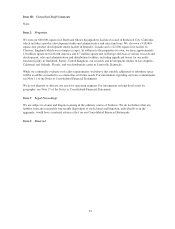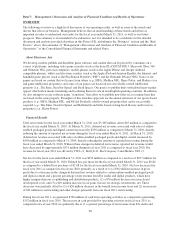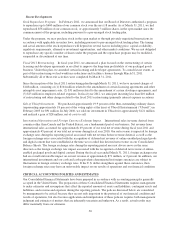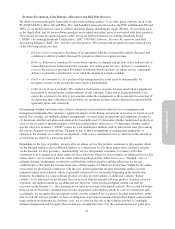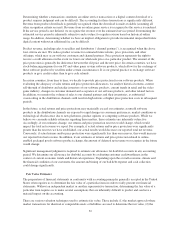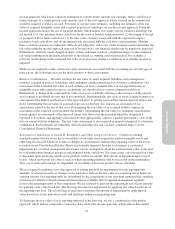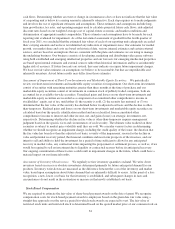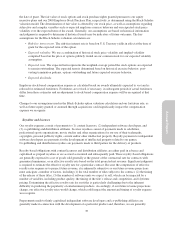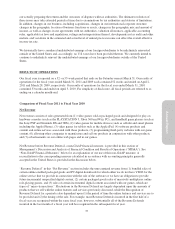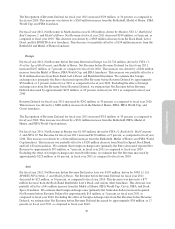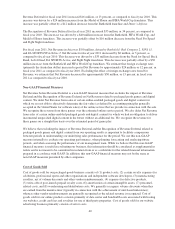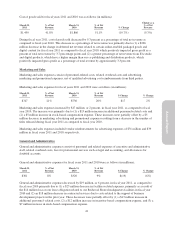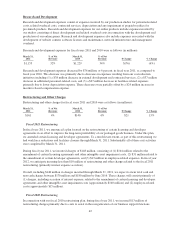Electronic Arts 2011 Annual Report Download - page 108
Download and view the complete annual report
Please find page 108 of the 2011 Electronic Arts annual report below. You can navigate through the pages in the report by either clicking on the pages listed below, or by using the keyword search tool below to find specific information within the annual report.Determining whether a transaction constitutes an online service transaction or a digital content download of a
product requires judgment and can be difficult. The accounting for these transactions is significantly different.
Revenue from product downloads is generally recognized when the download is made available (assuming all
other recognition criteria are met). Revenue from an online game service is recognized as the service is rendered.
If the service period is not defined, we recognize the revenue over the estimated service period. Determining the
estimated service period is inherently subjective and is subject to regular revision based on historical online
usage. In addition, determining whether we have an implicit obligation to provide incremental unspecified future
digital content without an additional fee can be difficult.
Product revenue, including sales to resellers and distributors (“channel partners”), is recognized when the above
four criteria are met. We reduce product revenue for estimated future returns, price protection, and other
offerings, which may occur with our customers and channel partners. Price protection represents the right to
receive a credit allowance in the event we lower our wholesale price on a particular product. The amount of the
price protection is generally the difference between the old price and the new price. In certain countries, we have
stock-balancing programs for our PC and video game system software products, which allow for the exchange of
these software products by resellers under certain circumstances. It is our general practice to exchange software
products or give credits rather than to give cash refunds.
In certain countries, from time to time, we decide to provide price protection for our software products. When
evaluating the adequacy of sales returns and price protection allowances, we analyze historical returns, current
sell-through of distributor and retailer inventory of our software products, current trends in retail and the video
game industry, changes in customer demand and acceptance of our software products, and other related factors.
In addition, we monitor the volume of sales to our channel partners and their inventories, as substantial
overstocking in the distribution channel could result in high returns or higher price protection costs in subsequent
periods.
In the future, actual returns and price protections may materially exceed our estimates as unsold software
products in the distribution channels are exposed to rapid changes in consumer preferences, market conditions or
technological obsolescence due to new platforms, product updates or competing software products. While we
believe we can make reliable estimates regarding these matters, these estimates are inherently subjective.
Accordingly, if our estimates change, our returns and price protection reserves would change, which would
impact the total net revenue we report. For example, if actual returns and/or price protection were significantly
greater than the reserves we have established, our actual results would decrease our reported total net revenue.
Conversely, if actual returns and/or price protection were significantly less than our reserves, this would increase
our reported total net revenue. In addition, if our estimates of returns and price protection related to online-
enabled packaged goods software products change, the amount of deferred net revenue we recognize in the future
would change.
Significant management judgment is required to estimate our allowance for doubtful accounts in any accounting
period. We determine our allowance for doubtful accounts by evaluating customer creditworthiness in the
context of current economic trends and historical experience. Depending upon the overall economic climate and
the financial condition of our customers, the amount and timing of our bad debt expense and cash collection
could change significantly.
Fair Value Estimates
The preparation of financial statements in conformity with accounting principles generally accepted in the United
States often requires us to determine the fair value of a particular item in order to fairly present our financial
statements. Without an independent market or another representative transaction, determining the fair value of a
particular item requires us to make several assumptions that are inherently difficult to predict and can have a
material impact on the accounting.
There are various valuation techniques used to estimate fair value. These include (1) the market approach where
market transactions for identical or comparable assets or liabilities are used to determine the fair value, (2) the
32




